3/15/2010
Media: Rice Hulls and PGRs
Chris Currey, Diane Camberato, Ariana Torres and Roberto Lopez
Parboiled rice hulls have proven to be an attractive media component for growers wishing to incorporate a sustainable product into their crop production. An agricultural by-product, rice hulls provide aeration, are safe for employees to handle and work with, and are well-suited for composting or incorporation into the garden bed by the consumer.
To our knowledge, no published research currently exists on the effects of parboiled rice hulls on PGR drench efficacy, so we took on a project at Purdue University. Our objectives in this study were to identify the interaction between different media components, PGR active ingredients and application rates.
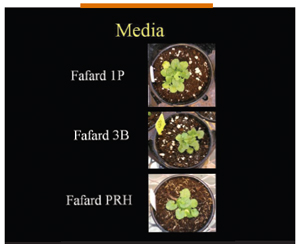 Figure 1. Pansy Delta Orange Blotch transplanted into media containing peat and perlite (Fafard 1P Mix), peat, bark, perlite and vermiculite (Fafard 3B Mix) and peat and rice hull (Fafard Custom RHM).
Figure 1. Pansy Delta Orange Blotch transplanted into media containing peat and perlite (Fafard 1P Mix), peat, bark, perlite and vermiculite (Fafard 3B Mix) and peat and rice hull (Fafard Custom RHM).
The study
In February 2009, we took delivery of plugs of calibrachoa Callie Deep Yellow and pansy Delta Orange Blotch from C. Rakers & Sons. Two days later, we transplanted the young plants into 4.5-in. round pots filled with three different soilless media: peat and perlite (“PP”; Fafard 1P Mix), peat and parboiled rice hulls (“PRH”; Fafard Custom RHM), or peat, bark, perlite and vermiculite (“PB”; Fafard 3B Mix). Specific media composition is outlined in Table 1 and Figure 1. Eleven days later, we treated the calibrachoa and pansy with 2.5 oz. drenches per pot of clear water or PGR solutions containing Bonzi (paclobutrazol) or Concise (uniconazole) at the concentrations outlined in
Table 2.
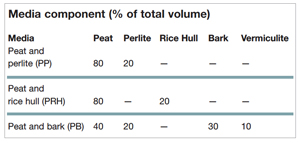 Table 1. Percentage (by volume) of individual components in peat and perlite (Fafard 1P Mix), peat and rice hull (Fafard Custom RHM) and peat, bark, perlite and vermiculite (Fafard 3B Mix) media used in this study.
Table 1. Percentage (by volume) of individual components in peat and perlite (Fafard 1P Mix), peat and rice hull (Fafard Custom RHM) and peat, bark, perlite and vermiculite (Fafard 3B Mix) media used in this study.
We grew the plants in a glass-glazed greenhouse at a constant temperature of 65F (18C) under a 16-hour photoperiod (6 a.m. to 10 p.m.) consisting of natural day length with day-extension lighting provided from high-pressure sodium lamps. We irrigated as necessary with acidified water containing 200 ppm N from a 15-5-15 feed (Excel 15-5-15 Cal-Mag). Plant height (pansies) or length of the longest stem (calibrachoa) was measured weekly, and final measurements were made six weeks after treatment.
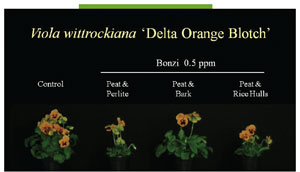 Figure 2. Pansy Delta Orange Blotch untreated and grown in a peat and perlite media (control) or grown in peat and perlite, peat, bark, perlite and vermiculite or peat and rice hull media and treated with a 2.5 fl. oz. drench of 0.5 ppm Bonzi solution.
Figure 2. Pansy Delta Orange Blotch untreated and grown in a peat and perlite media (control) or grown in peat and perlite, peat, bark, perlite and vermiculite or peat and rice hull media and treated with a 2.5 fl. oz. drench of 0.5 ppm Bonzi solution.
The height of pansies not treated with PGRs (the clear water control) was similar regardless of which media they were grown in. Additionally, there were no differences in height between plants grown in any of the media mixes when treated with 0.5 ppm Concise. However, as we increased the Concise concentrations to 1.0 ppm, there were apparent differences in height. Plants grown in the PB media were only 3% shorter than untreated plants, while plants grown in PP media or the PRH were 20% and 33% shorter, respectively, than untreated plants.
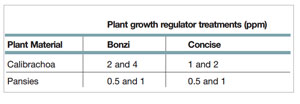 Table 2. Application rates for Bonzi (paclobutrazol) and Concise (uniconazole) media drenches for calibrachoa and pansies.
Table 2. Application rates for Bonzi (paclobutrazol) and Concise (uniconazole) media drenches for calibrachoa and pansies.
The results with pansies treated with Bonzi were comparable to plants treated with Concise. Plants grown in PP media and PRH media were 45% to 57% shorter than untreated plants when treated with 0.5 ppm Bonzi, while plants grown in PB media were only 22 % shorter than untreated plants (Figure 2). As Bonzi concentrations increased to 1.0 ppm, pansies grown in PP or PRH media were 3.1 to 3.3 inches tall, while pansies grown in PB were 4.3 inches tall.
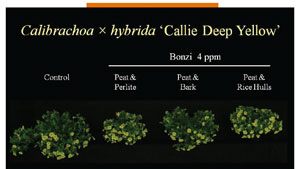 Figure 3. Calibrachoa Callie Deep Yellow untreated and grown in a peat and perlite media (control) or grown in peat and perlite, peat, bark, perlite and vermiculite or peat and rice hull media and treated with a 2.5 fl. oz. drench of 4.0 ppm Bonzi solution.
Figure 3. Calibrachoa Callie Deep Yellow untreated and grown in a peat and perlite media (control) or grown in peat and perlite, peat, bark, perlite and vermiculite or peat and rice hull media and treated with a 2.5 fl. oz. drench of 4.0 ppm Bonzi solution.
With calibrachoa, stem length of untreated plants was similar with all three media mixes. A 1.0 ppm Concise drench reduced stem elongation for plants in all media. But plants treated and grown in PB medium had stems 1.0 to 1.5 inches longer than treated plants grown in PP and PRH. When Concise concentration increased to 2.0 ppm, the stem length was reduced 47% to 54% regardless of which media plants were grown in.
Calibrachoa grown in the PB medium and treated with a 2.0 ppm Bonzi drench were 2.2 to 2.3 inches longer than plants grown in PP and PRH media. A similar trend was observed for plants treated with 4.0 ppm Bonzi drench solutions (Figure 3).
Previous research at the University of Florida has shown that peat, perlite and vermiculite have little inhibitory effects on PGRs when applied as drenches, while bark does reduce efficacy. We also observed this in our experiment, with pansies and calibrachoa grown in the PB media and treated with drenches of Bonzi or Concise. However, with both species, there were no differences observed between plants grown in the PP and PRH media when given the same PGR treatments. Since the percentage (by volume) of peat in the PP and PRH media was 80% and the percentage of perlite or rice hulls was 20% (Table 2), it appears as though the substitution of rice hulls for perlite did not affect the activity of Bonzi or Concise drenches.
The results
So what does this mean for growers? Our evaluation of commercially available media mixes and PGR drenches validates previous research, while providing new insight into rice hulls and any PGR interactions with them. As expected, the media containing bark reduced the efficacy of Bonzi and Concise drenches, but there was no difference between stem length (calibrachoa) or plant height (pansies) between untreated plants grown in PP or PRH media.
This was not a study on overall horticultural performance of rice hulls as a media component, however. We focused only on the effect of media components on PGR drench activity. More in-depth studies on the horticultural quality of crops grown in rice hulls have been done by researchers at the University of Arkansas. We feel the results on the interaction of rice hulls and PGR drenches are clear, though we always caution growers to do their own trials to determine what is effective in production for them.
GT
Christopher J. Currey (ccurrey@purdue.edu) and Ariana P. Torres (torres2@purdue.edu) are graduate research assistants, Diane M. Camberato (dcambera@purdue.edu) is a greenhouse research technician, and Roberto G. Lopez (rglopez@purdue.edu) is an assistant professor and floriculture extension specialist in the Department of Horticulture and Landscape Architecture at Purdue University. Roberto is a member of the Floriculture Sustainability Research Coalition. The authors would like to thank C. Rakers & Sons for plant material, Conrad Fafard, Inc. for media, Fine Americas, Inc. and Syngenta Crop Protection for PGRs and funding, ITML for pots and Scotts’ Co. for fertilizer.